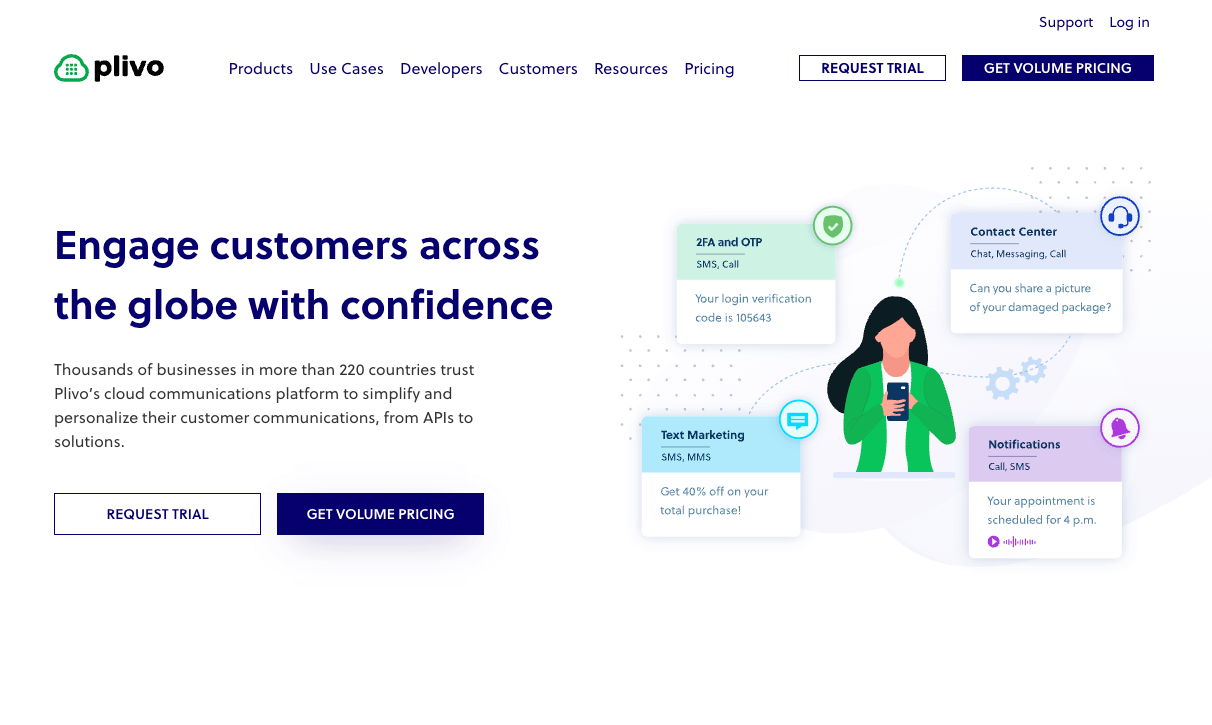Ever since the US Federal Election Commission (FEC) approved the use of fundraising via SMS text message in 2012, SMS has become a main engagement tool for presidential candidates. Barack Obama became the first presidential candidate to capitalize on the new “text-to-donate” option. In addition to fundraising, this 2016 election has witnessed extensive use of SMS by candidates for other purposes, including reminders of registration deadlines, key event highlights, and even helping voters find nearby polling stations.
This is not surprising, since millennials have been a key voter demographic in this election, and an overwhelming 88.7% of them check their text messages almost instantly. Dynamark International’s Mobile Intelligence Review, 2nd Edition, reported that the average open rate of a text message is 98%, almost three times the open rate of emails.
SMS has been the preferred communication tool for both volunteers and voters. By using text messaging instead of phone calls, volunteers don’t have to hear awkward and stressful rejections, and voters no longer need to be disturbed by campaign calls.
Here what worked and what didn’t work when candidates leveraged SMS text messaging in 2016. Some campaigns succeeded in boosting voter engagement, increasing donations, and driving voter registration. Others neglected subscription bases and even violated SMS regulations.
What worked
Although Bernie Sanders failed to become the Democratic nominee, the runner-up ran one of the most successful SMS text messaging campaigns to date. Sanders’ campaign used third-party apps such as Hustle to connect directly to millennials, who rarely feel connected to presidential candidates. During his campaign, 95% of the supporters who showed up at some of his rallies heard about them through text message notifications.
Interactions with users were personalized and prompted three calls to action: getting friends registered to vote, inviting friends to volunteer or attend campaign events, and inviting friends to install the Bernie Messenger app. These calls to action gained the campaign more than 50,000 mobile subscribers.
At the end of his presidential campaign and in light of leaked emails that suggested Hillary Clinton’s nomination was an organized effort within the party, Bernie used text messaging to urge his supporters not to protest during the Democratic National Convention.
Following in Obama’s foot steps, Hillary Clinton’s campaign capitalized on SMS from the beginning. In 2015, GIFs and memes sent from the “Texts from Hillary” campaign during the GOP debate went viral and became an internet sensation. Hillary’s top digital strategist, Teddy Goff, stated that texting has been a key tool for swaying voters, raising money, and organizing volunteers. Text messaging has been such a strong engagement tool that Hillary announced her choice of a running mate through a text message to her supporters.
The Clinton campaign also launched an SMS bot that texts subscribers Donald Trump quotes. Not only can recipients have conversations with the SMS bot, they can also reply with the keyword “SOURCE” to receive the link to the referenced article, video, or transcript. Bots aside, Steph Hannon, CTO for Hillary for America, has stated that SMS has been “a key component of our digital program to keep supporters in the loop about breaking news.”
Throughout the campaign, Clinton also used SMS as a way to gauge voter sentiments on key issues, deliver personal messages regarding endorsements, and make attacks on Republican contenders.
As we get closer to the elections, SMS has become a battleground for gaining voter share. Last week, Clinton’s campaign launched an SMS hotline dedicated to protecting Spanish-speaking voters. Voters can report voter intimidation and suppression and get connected to poll observers and attorneys within 24 hours.
Not only can supporters receive text message updates from Clinton by signing up on her website or by texting to a short code phone number, they can also download an app that’s intended to help them influence friends’ votes. The app syncs iPhone contacts with Facebook friends and sends a personal text messages to try to sway potential voters. According to Clinton’s campaign, the app has been a huge success and has already been downloaded more than 150,000 times.
What hasn’t worked
On the other hand, Republican nominee Donald Trump has been using SMS in a more traditional way as a one-way notification tool for campaign updates. Even though the Trump campaign has implemented short code SMS, it’s making limited use of it for engaging subscribed voters. Instead of gathering data points about subscribers by asking targeted questions, Trump’s campaign is treating SMS like a social media platform to broadcast duplicate content. Surprisingly, Trump’s campaign is not taking donations through SMS.
SMS has powered many campaigns, but Trump’s could wind up costing him. In April, a massive and unsolicited text message campaign went out to thousands of unsubscribed recipients, who in response joined together in a class-action lawsuit that could cost his campaign millions of dollars. Text messaging in the United States is one of the most heavily regulated SMS services in the world. As part of the Telephone Consumer Protection Act, SMS text messages in the US require strict opt-in and opt-out procedures. Deviating from the regulations can give consumers the right to sue.
Republican candidate Ted Cruz kicked off his campaign by telling supporters to text GROWTH to a short code during an early speech, which helped him gain more than 16,000 new SMS subscribers. He also used SMS campaigns to collect donations, which saw about 80% of donors complete text contributions, compared to a mere 30% completion rate by people filling out credit card forms.
However, since keywords are important to subscriber engagement through SMS short codes, the Cruz campaign’s misread of the opt-in keyword likely led to missed opportunities. Cruz had instructed supporters to sign up to his SMS campaign by texting “Constitution” to his short code, but the short code was set up only for the keyword “Imagine,” so those who texted “Constitution” would not have been added to the campaign.
What we’ve learned
Thus far, the 2016 elections has taught us how powerful SMS can be to survey subscriber data and engage with supporters. However, unlike with other communication mediums such as Twitter and Facebook, candidates must follow strict telecommunications guidelines.
Automated messages on a large scale, such as the those from political candidates, should be sent via short codes instead of regular 10-digit long codes, because long codes are reserved for peer-to-peer communication — one-on-one exchanges of text messages between two mobile subscribers. Short codes are designated for businesses that send application-to-person (A2P) communication, such as you typically experience with SMS alerts from banks, flight notifications while traveling, and password authentication for logins.
Following best practices for text messaging can make a positive impact on any campaign. Candidates should provide:
- Easy opt-in: There are many acceptable opt-in mechanisms, including website signup, physical form filling, and texting. But to make SMS available to all users, it’s important to assess how and what users are familiar with. Websites and SMS will likely give a campaign the largest reach, and can engage a younger subscriber base. However, if physical form filling is the only mechanism available, it’s critical to ensure that the subscribers understand what they’re signing up for, or else reports of unsolicited messages from confused voters can shut down your campaigns.
- Memorable phone numbers: Short codes with repeating digits are a great way to make your phone number memorable. Alternatively, you can also purchase a vanity short code, which allows you to choose the number you want instead of getting assigned a random short code upon purchase. Even though vanity short codes can be more expensive, it’s worth the money if you can get a memorable word as your short code. For example, Coca Cola’s short code is 36569 (ENJOY), and Sprite’s short code is the name of their product: 777483 (SPRITE).
- Memorable keywords: Keywords should be both memorable and related to your campaign. The easier it is to remember and opt in for your campaigns, the more potential subscribers you can acquire.
- Regular two-way engagement: Amassing subscribers is only the beginning. Active and regular engagement can be a key piece in getting voter feedback and expanding on your subscriber base by leveraging existing subscribers. Bernie Sanders used this mechanism well when his campaign launched a mechanism to share campaign and rally details with friends.
- Engage them in other ways: Campaigns can use SMS as a mechanism to get voters to sign up for email messages.















.png)
